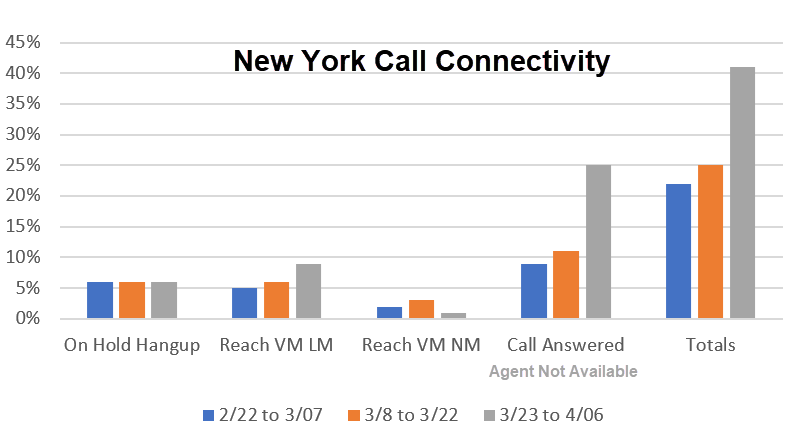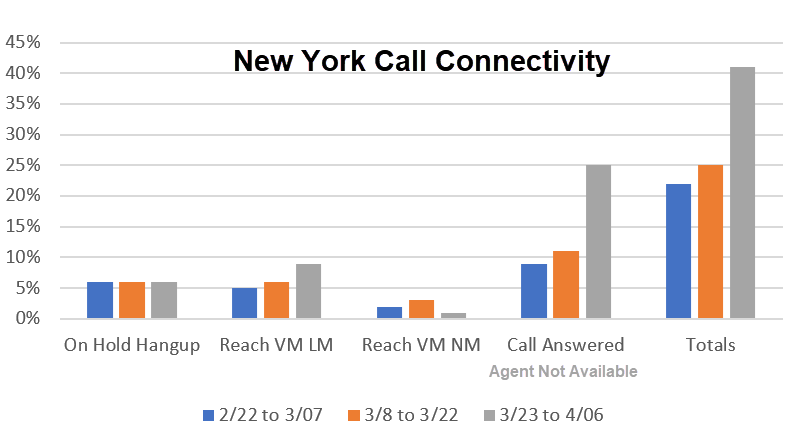By the time the weekend hit, sales call volume dropped by almost 20%. That said, based on a diverse 50-dealer sampling, operations stayed relatively the same. Connectivity and phone-skill metrics indicated almost no changes in how calls were being handled.
by Cory Wright
As much of the nation is ordered to shelter in place or observe extreme social distancing, it’s of no surprise that auto dealers are evolving the way they do business to continue serving their customers. The automotive eco-system has always found a way to grow and thrive when faced with adversity, especially New Yorkers.
Outsiders sometimes label dealers as “slick-talkers”, but in the midst of a pandemic, it’s time to become the absolute best “slick-listeners” we’ve ever been. We decided to zoom in on the US epicenter of COVID-19 in New York now that Empire State Development Corporation has authorized automotive sales to be conducted remotely or electronically. Our aim was to listen to what was happening, identify trends, and use that data to help dealers be more prepared for when/if their state encounters a similar level of outbreak.
On March 1st 2020, New York confirmed its first case of Coronavirus. One day later, Mayor De Blasio tweeted out: “Since I’m encouraging New Yorkers to go on with your lives + get out on the town despite Coronavirus, I thought I would offer some suggestions,” where he went on to endorse the showing of the motion picture “The Traitor”. Despite setting a relaxed tone, New Yorkers were seemingly skeptical and their waning interest in venturing out was apparent over the phones.
By the time the weekend hit, sales call volume dropped by almost 20%. That said, based on a diverse 50-dealer sampling, operations stayed relatively the same. Connectivity and phone-skill metrics indicated almost no changes in how calls were being handled. For almost 3 weeks, our data indicates very little fluctuations or anomalies.
On March 22nd, however, when Governor Cuomo instituted a stay at home order, the call data began to reflect a uniform but drastically different way of doing business. Sales call volume crashed 57% from the volume seen at the onset of NY’s first Coronavirus case. Not only did call volume decrease, but connectivity plummeted drastically. The lion share of this 20% decrease in connectivity was due to the dealer’s inability for a live agent to transfer the caller to their intended party.
So, why with a decrease of over half the call volume were dealers still struggling to connect customers from a live receptionist to the help they asked for? The reasons are many. Some had to drastically reduce their staff to stay open. Many rerouted their tracking numbers from their state-of-the-art phone systems to cell phones for remote consultations.
What was once an almost automatic and seamless warm transfer process (phone system has the ability to ensure the requested party is able to take the call), became a trivial and mind-numbing one that 25% of the time resulted in the receptionist taking a message. That represented the best-case scenario of calls that didn’t reach their intended party. 6% of callers hung up while holding, which surprisingly stayed the same throughout the past month. Lastly, 10% of calls hit a voicemail.
Typically, our data shows a 50-50 split in those who leave a message vs. those who don’t leave a message. However, during the 2 weeks directly after the stay at home order was issued, 90% of those who hit voicemail did leave a message, 10% did not.


What does the data tell us from a connectivity standpoint?
- Customers can sense when something big is coming. Pay attention to unusual drops in volume. It can signal a future shift and allow you time to adjust gracefully.
- A 20% decrease in connectivity equates to a TON of lost business. If you don’t already have one, it’s time to create and test a plan for routing calls efficiently and working almost entirely remotely. At an absolute minimum, know how to access your call data to return calls to missed opportunities.
- Trading in your state-of-the-art VoIP Phone system and replacing it with a network of cell phones, working remotely comes with a litany of challenges. Luckily, with some practice and advanced routing strategies, you can make it work relatively seamlessly.
- Voice messages do matter. Especially during a pandemic. Sending a customer to voicemail in 2020 should be a last resort, but if your receptionist cannot take a message or perform a warm transfer, at a minimum, make sure that voicemails are setup professionally and they are checked frequently. Customers expect that if they put the effort into leaving one, dealers will make the effort to call them back.
How did this pandemic change the way calls were handled?
Dramatically. To my surprise, the data suggested that it actually impacted something as simple as introducing ourselves on the call. Post stay at home order, agent identification dropped 5%.
I imagine that everyone can agree that while it’s small pennies in comparison to other data points, your first impression matters. It weighs heavily on how the rest of the call plays out. In a time where customers are looking for an establishment they can trust, we need to be prepared to wow the customer from hello.
On the bright side, we observed an increase of 5% more contact information being obtained. Earning customer contact information is not only critical during these times, but it serves as a opportunity to provide transparency. Given the current state, answers can change by the hour. We owe it to our customers to be able to rapidly follow-up with them as the purchasing landscape changes.
Unfortunately, despite the uptick in collecting contact information, customers were promised a return call 35% of the time, 12% more frequently than before the stay at home order. While some may see this as a measure taken to increase accuracy, I struggle to believe there wasn’t a better way to find out the answers to customers’ questions, especially when the overwhelming majority of calls were in regard to basic availability.
Based on our data, being prepared has a direct correlation with setting an appointment with a prospect. Unfortunately, we saw appointment set percentages drop from 47% down to 12%. There is always a story behind the numbers.
What does the data tell us from a skill perspective?
- We must rise to the occasion. Customers who are calling us now need us as much as we need them. We should not only thank them for their call, but also introduce ourselves properly. This is not a time to relax our professionalism. It’s a time to showcase it.
- 55% contact information obtained is decent, but it’s only just over half of our customers who are willing to even permit us to follow back up with them. Focus on the customer first and earn the contact information as a result of the deep rapport you’ve built with the customer.
- Coronavirus caused some dealers to work remotely, reducing their ability to answer questions accurately. Webcams, up to date inventory, and a process for answering questions can change the game when it comes to earning the right to ask for an appointment. If you can’t answer their question, it’s almost silly to try and invite them to your dealership. Especially during a pandemic.
What else did the data tell us?
Lease calls are surging at 40% of overall call volume, tracking 11% higher than March. When customers call about a lease, we are seeing an impressive average appointment set rate of 43%. Monumentally higher than the set rate of used cars (17%) and new cars (6%) currently. Unfortunately, 38% of customers asking about leasing aren’t making it through to someone who can help them.
The good news? Call volume appears to slowly be rebounding in New York as dealers get creative and make the best of this unprecedented time. By analyzing your call data, you can learn the areas that need focus during this time and the new trends we are seeing so you can start training your team and flattening the curve.






